भारत के संगीत वाद्ययंत्र
The Musical Instruments section of the Indian Culture portal contains information about a range of instruments from across India. The Indian Culture portal has researched and is happy to present information about the countless exquisite musical instruments of our country. The extent and diversity of such instruments is vast and we will keep on adding to this section.
Natya Shastra by Bharat Muni (composed between 200 BC and 200 AD) clubbed musical instruments into four groups: Avanaddha Vadya (membranophones or percussion instruments), Ghan Vadya (idiophones or solid instruments), Sushir Vadya (aerophones or wind instruments), and Tat Vadya (chordophones or stringed instruments). This ancient classification given by Bharat Muni for the musical instruments of India was later adapted in 12th century Europe and used for the classification of the Musical Instruments of Europe. Later, Greek labels were assigned to the four classifications - Chordophones for Tat Vadya, Membranophones for Avanaddha Vadya, Aerophones for Sushir Vadya, and Autophones for Ghan Vadya. Thus, the western system of classification is based on the ancient Indian Natya Shastra.
Ancient Indian statues and paintings show the use of musical instruments similar to what we see today. As many different materials are used in the manufacturing process, including leather, wood, metal, and pottery the making of musical instruments requires great skill and also a basic knowledge of music and acoustical principles.
The Indian Classical Musical system has two major traditions - Hindustani and Carnatic. Additionally, there are several other traditions such as folk, tribal, etc. From ancient times, Indian musicians from these traditions have developed and performed with traditional and indigenous musical instruments that suited their style.
Therefore, the musical instruments of India bring along a rich heritage and form an integral part of the cultural traditions of this country.
AVANADDHA VADYA Percussion Instruments
TAT VADYA Stringed Instruments
GHAN VADYA Solid Instruments
SUSHIR VADYA Wind Instruments
INCREDIBLE TEXTS On Indian Music
Avanaddha vadya
These are percussion instruments. Sound is produced by a stretched membrane, such as a drum. Membranophonic instruments act as skin-vibrators because they produce sound-waves by vibrations of a stretched skin or membrane when struck, plucked, or stroked. A hollow vessel is covered with a membrane that generates beats when struck. Percussion instruments can be classified by modes of playing:
- layed by hand like mridangam;
- played using sticks like nagara;
- played partly by hand and partly by stick-like tavil;
- self struck like damaru;
- and where one side is struck and the other side stroked like a perumal madu drum.
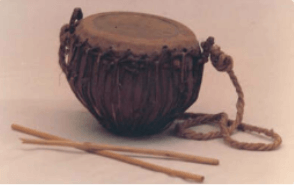
BIDI in Karnataka
Material: Clay, Parchment, Leather
A small deep clay bowl with skin covered face, tied with leather straps with the help of a hoop and holes. Slung from the neck, played with two thin sticks. Used in processions and religious ceremonies.
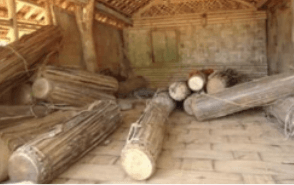
DAMA
Material: Wood, Parchment
Dama is a percussion instrument made of wood, parchment, and softood. It is a folk instrument, found in Tripura and Meghalaya. A hand drum, it is used by the tribal communities of the hilly areas.

BURRAKATHA DAKKI
Material: Brass, Parchment, Cotton
Burrakatha Dakki is a percussion instrument made of brass, parchment, cotton and iron. A pitcher shaped vessel, mostly used by ‘Burrakatha’ balladeers.

DAVANDI
Material: Brass, Parchment, Wood
Davandi is a percussion instrument made of brass, wood, and parchment. Found in Tamil Nadu, this hourglass-shaped small drum is used in religious occasions, auspicious occasions, and temple services.

ANANDALAHARI
Material: Earthernware, wood
A small deep clay bowl with skin covered face, tied with leather straps with the help of a hoop and holes. Slung from the neck, played with two thin sticks. Used in processions and religious ceremonies.
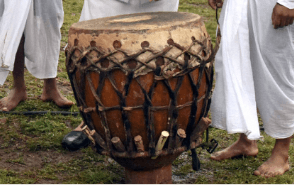
BOM
Material:Softwood, Leather
Dama is a percussion instrument made of wood, parchment, and softood. It is a folk instrument, found in Tripura and Meghalaya. A hand drum, it is used by the tribal communities of the hilly areas.
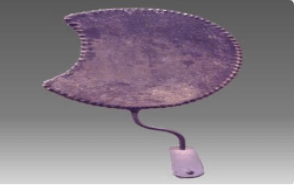
CHANDRA PIRAI
Material: Brass, Parchment, Cotton
Burrakatha Dakki is a percussion instrument made of brass, parchment, cotton and iron. A pitcher shaped vessel, mostly used by ‘Burrakatha’ balladeers.
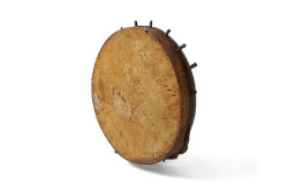
CHANGU
Material: Brass, Parchment, Wood
Davandi is a percussion instrument made of brass, wood, and parchment. Found in Tamil Nadu, this hourglass-shaped small drum is used in religious occasions, auspicious occasions, and temple services.
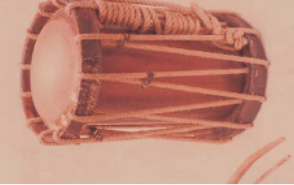
CHENDA
Material: Clay, Parchment, Leather
A small deep clay bowl with skin covered face, tied with leather straps with the help of a hoop and holes. Slung from the neck, played with two thin sticks. Used in processions and religious ceremonies.
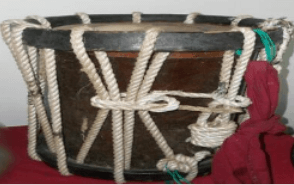
CHENDE
Material: Wood, Parchment
Dama is a percussion instrument made of wood, parchment, and softood. It is a folk instrument, found in Tripura and Meghalaya. A hand drum, it is used by the tribal communities of the hilly areas.
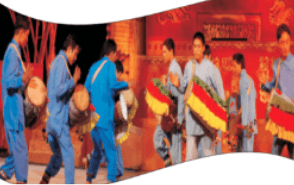
Chyabrung
Material: Brass, Parchment, Cotton
Burrakatha Dakki is a percussion instrument made of brass, parchment, cotton and iron. A pitcher shaped vessel, mostly used by ‘Burrakatha’ balladeers.

DAGAR
Material: Brass, Parchment, Wood
Davandi is a percussion instrument made of brass, wood, and parchment. Found in Tamil Nadu, this hourglass-shaped small drum is used in religious occasions, auspicious occasions, and temple services.
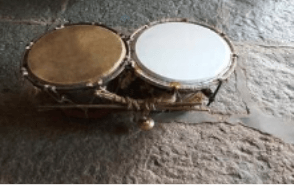
DAMARAM
Material: Clay, Parchment, Leather
A small deep clay bowl with skin covered face, tied with leather straps with the help of a hoop and holes. Slung from the neck, played with two thin sticks. Used in processions and religious ceremonies.
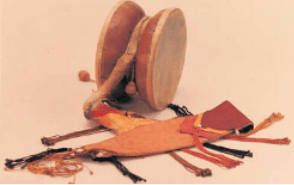
DAMARU
Material: Wood, Parchment
Dama is a percussion instrument made of wood, parchment, and softood. It is a folk instrument, found in Tripura and Meghalaya. A hand drum, it is used by the tribal communities of the hilly areas.
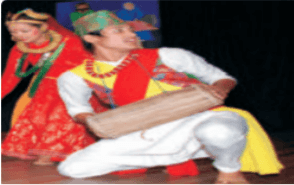
DAMPHU
Material: Brass, Parchment, Cotton
Burrakatha Dakki is a percussion instrument made of brass, parchment, cotton and iron. A pitcher shaped vessel, mostly used by ‘Burrakatha’ balladeers.
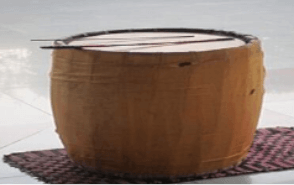
DHAK
Material: Brass, Parchment, Wood
Davandi is a percussion instrument made of brass, wood, and parchment. Found in Tamil Nadu, this hourglass-shaped small drum is used in religious occasions, auspicious occasions, and temple services.




